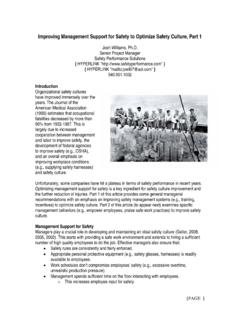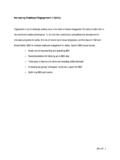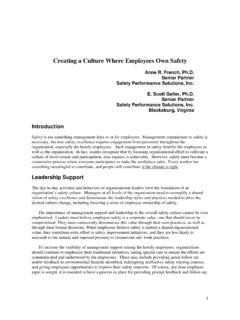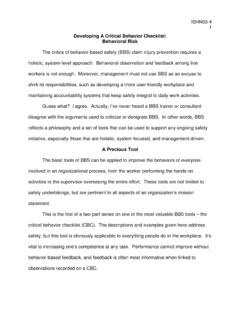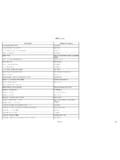Transcription of Increasing the Impact of Signs and Slogans - Safety
1 ISHN96-5 1 Increasing the Impact of Signs and Slogans W. Edwards Deming told us to eliminate Signs , Slogans , exhortations, and objectives from the workplace. What did he mean? Did he mean we ought to stop giving people directions to follow and goals to shoot for? If he did, he was denying the basic Activator-Behavior-Consequence (ABC) framework for behavior-based Safety . Substantial research has verified that behavior is influenced markedly by activators (or stimuli like Signs preceding behavior) and by consequences (pleasant or unpleasant events following behavior). I don t think Dr. Deming was disregarding behavioral science principles with his point about eliminating Signs , Slogans , and exhortations.
2 Rather, he was criticizing the standard top-down development and display of performance activators. If we keep on attempting to activate behavior with standard practices, we might as well eliminate them all together. As currently used, Signs , Slogans , and exhortations for Safety might only raise expectations without giving relevant and meaningful direction. As such, they could do more harm than good. The ABC principle of direction from activators is not wrong, however. The way the principle gets translated into procedures or operations needs elimination or improvement. In this article, I offer six guidelines for Increasing the Impact of activator techniques.
3 These guidelines might imply that some of your current Signs , Slogans , goals and exhortations ought to be eliminated, as Deming suggested. But, if you follow these guidelines when developing new activators you will not only increase safe behavior and decrease at-risk behavior, you will help to develop the kind of attitudes needed to sustain behavior change. Guideline 1: Specify Behavior Behavioral research demonstrates that Signs with general messages and no specification of a desired behavior to perform (or an undesirable behavior to avoid) have very little Impact on ISHN96-5 2 actual behavior. But Signs that refer to a specific behavior can be beneficial.
4 Therefore, don t expect Signs or Slogans with general exhortations like Think Safe, Eliminate Accidents, and Meet Our Goal of Zero Injuries to have much Impact . On the other hand, activators that give specific direction can influence behavior and thus prevent injuries. Specific messages might tell people where certain behaviors are needed or appropriate (such as, Hard-Hat Zone, Designated Smoking Area, and Ear Protection Required ) or give direction on how to perform safely (such as Lift With Legs, Walk Within the Yellow Lines, and Buckle Up for Safety ). Although activators should specify a response to perform or avoid, they should not be overly complex.
5 Signs with a lot of words are easy to overlook -- with time complex Signs just blend into the woodwork. But, of course, even simple and specific messages will also lose their Impact with time. Following the next guideline explains why this is the case. Guideline 2: Maintain Salience with Novelty It is perfectly natural for activators like sign messages to lose their Impact over time. This process is called habituation, and it s considered to be the simplest form of learning. Through habituation we learn not to respond to an event that occurs repeatedly. If there is no obvious consequence (good or bad) from responding to a stimulus, the organism stops reacting to it.
6 It s a waste of time and energy to continue responding to an activator that seems to be insignificant. What is the relevance of habituation for Safety ? It s human nature to habituate to everyday activators in our environment that are not supported by consequences. And this is the case with many Safety activators. So we should expect the same sign or slogan to lose its influence over time unless consequences are in place to support the message. ISHN96-5 3 A sign requesting the use of personal protective equipment might eventually be ignored, for example, if consequences are not in place to support the activator.
7 And, I don t mean only the availability of penalties if the message is not followed. Given the natural negative consequences for most safe behavior (such as inconvenience, discomfort, or inefficiency), it is essential to add some positive consequences (like positive feedback or recognition) to support compliance with safe-behavior activators. Guideline 3: Vary the Message What does habituation tell us about the design of Safety activators? Essentially, we need to vary the message. When an activator changes it can become more salient and noticeable. Over the years I ve noticed a variety of techniques for changing the message on Safety Signs .
8 There are removable slats to place different messages. I m sure most of you have seen computer-generated Signs with an infinite variety of Safety messages. Some plants even have video screens in break areas, lunch rooms, visitor lounges, and hallways that display many kinds of Safety messages, conveniently controlled by user-friendly computer software. Who determines the content of these messages? I know who--the target audience for these Signs . The same people expected to follow the specific behavioral advice should have as much input as possible in defining message content. Many organizations can get suggestions for Safety messages just by asking.
9 But if employees are not accustomed to giving Safety suggestions, they might need a positive consequence to motivate their input. I ve transitioned to the next guideline. Guideline 4: Involve the Target Audience This guideline should be obvious by now. It s relevant for developing and implementing any behavior-change intervention. When people contribute to a Safety effort, their ownership ISHN96-5 4 and commitment to both Safety and the improvement process increase. Of course, this guideline works both ways. When individuals feel a greater sense of ownership and commitment, their involvement in Safety achievement is more likely to continue.
10 Thus, involvement feeds ownership and commitment, and vice versa. When public trash receptacles include the logos of nearby businesses, the merchants whose logos are displayed typically take care of the receptacle, and keep the surrounding area clean. This guideline is also supported by the success of Adopt-a-Highway programs that have groups keep a certain roadway clear of litter and perhaps beautified with plants, scrubs, or flowers. Group ownership of public space typically leads to actively caring for its appearance. Guideline 5: Activate Close to Response Opportunity It s intuitive that the shorter the delay between a direction and the opportunity to follow the direction, the greater the probability of compliance.
